BACK TO EXHIBITS
The Quilts of Mary Gasperik

Ravenswood Historic Site, Livermore, California, March 1992. Photo by Mary's grandson David Gasperik.

Mary’s family at the Ravenswood show. Back: Winston Salser, Mark Salser, Karen Finn, Susan Salser, David Finn, David Gasperik. Middle: Joanne Gasperik, Kathy Gasperik Jacobs, Cathy Salser, Linda MacLachlan. Front: Kathy Jacob’s daughter Kim. Photo by David Gasperik.
Mary’s grandchildren are: Karen Finn, Susan Salser, Joanne Gasperik, Kathy Gasperik Jacobs, Linda MacLachlan, and David Gasperik. Mary’s great-grandchildren are: Mark Salser, David Finn, Kim Gasperik Jacobs, and Cathy Salser.

Hungarian Girls quilt. Photo by David Gasperik.

Indiana Wreaths. Photo by David Gasperik.

Left: Daisies Won’t Tell. Right: Leaf and Vines. Photo by David Gasperik.

Kim Jacobs with Bridal Bouquets. Photo by David Gasperik.

Left: Delectable Mountains. Middle: Grandmother’s Victory Garden. Right: Kim Jacobs and Calico Rose. Photo by David Gasperik.

Left: appliqued dresses. Middle: Peach Posy. Right: Colonial Quilting Bee. Photo by David Gasperik.

Left: Laurel Wreath. Middle: Roses and Forget-Me-Nots. Kim Jacobs. Right: Basket of Tulips. Photo by David Gasperik.

Left: Double Trellis, Kim Jacobs. Right: Morning Glory quilts. Photo by David Gasperik.
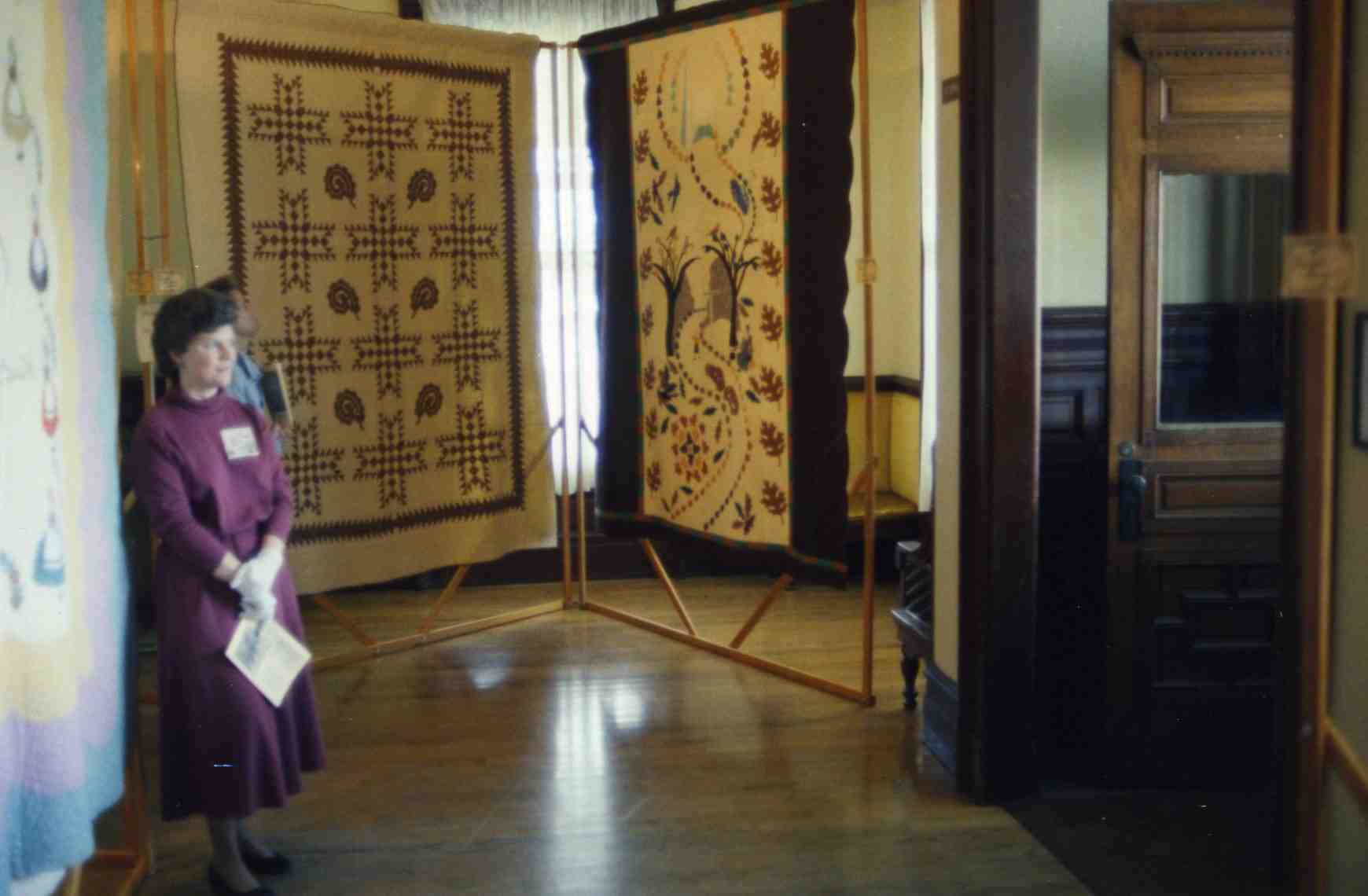
Left: Colonial Quilting Bee. Middle: Indian Feather Star. Right: Road to Recovery. Photo by David Gasperik.

Kim Jacobs with left: Sugar and Spice. Middle: What Are Little Boys Made of. Right: Four Little Pigs. Photo by David Gasperik.

Left: Laurel Wreath. Right: Roses and Forget-Me-Nots. Photo by David Gasperik.
Since the presentation of Mary Gasperik’s quilts in this exhibit, Gasperik’s granddaughter, Susan Salser, has done extensive research. Notice comments throughout the catalog where Salser updates, enhances, and corrects the record.
The Quilts of Mary Gasperik
Ravenswood Historic Site
3947 Arroyo Road, Livermore, California
10 a. m. to 4 p. m., March 14-15, 1992
Welcome to Ravenswood Historic Site Mary Gasperik Quilt Show featuring more than 50 creations by this unique and special quilter. This is the first time ever that so many of her quilts have been displayed together.
The Livermore Area Recreation Park District is indebted to three of Mary’s granddaughters, Karen Krueger Finn, Susan Krueger Salser and Linda Krueger MacLachlan, as well as to other family members, for making these quilts available for this show, and to the Amador Valley Quilters for funding and staffing this show.
Mary Gasperik was born Maria Mihalovits in Albertin Hungary (then part of the Austro-Hungarian empire) on Jan. 25, 1888. At age 16 she and her older sister Elizabeth emigrated to America, settling in the Chicago area. She married fellow Hungarian, Stephen Gasperik, on Nov. 18, 1906, and lived the rest of her life in the Chicago area.
She came to America very adept in sewing and cooking, including crocheting, cut-work embroidery, dressmaking, etc.

Mary at age 16, in Chicago.
Daughter Elsie Gasperik Krueger later told her daughters that Mary’s crocheting and embroidery decorated every conceivable object in the Gasperik living quarters, behind and above the grocery store which her father operated. Fringes, lace and embroidery abounded. They surrounded and clothed Elsie, who came to detest the elaborate over-decoration and fanciness which so pleased Mary.
Her work is even more impressive when you consider that she did not begin quilting until she was over 40 years of age.
Susan Krueger Salser thinks her grandmother began quilting as a result of the 1933 Sears Roebuck Quilt Contest and the 1933-34 Chicago World’s Fair Quilt Exhibit. This fair was called “The Century of Progress” and Mary’s earliest quilts were embroidered “Century of Progress” on the backs.
Mary carefully “read” newspapers of the time for quilt patterns and subscribed to the Detroit News especially for the quilting columns. Many of her quilts originated from published or traditional patterns, but she usually added more appliqué, more quilting, more embroidery, or changed the pattern in some way.
Although she learned to speak English when her children went to school, she could not read or write English well.
Mary thrived on competition and entered many contests with the remarkable results of earning numerous ribbons.
Her family says that when creating a quilt she worked almost non-stop, driven by the need to finish it and display it for family and friends and in competition.
Her family thinks she made more than 100 quilts, all either in Chicago or East Hazelcrest, Ill. However, some of the quilts have been lost, burned or worn out. All three Krueger granddaughters are interested in learning more about Mary’s quilts and tracing those that have disappeared.
Mary’s quilting skill and artistry was always appreciated by her family and friends, but only in a display of so many of her quilts, can one truly appreciate her talent and effort.
Mary’s Family
Mary and Stephen Gasperik had three children: Elmer, Elsie and Stephen.
Elmer married Doris Schultz and had Kathy (Jakob), Michael, Robert and David.
Elsie married Maynard Krueger and had Karen (Finn), Linda (MacLachlan) and Susan (Salser).

Mary and her granddaughters Karen, Linda, and Susan.
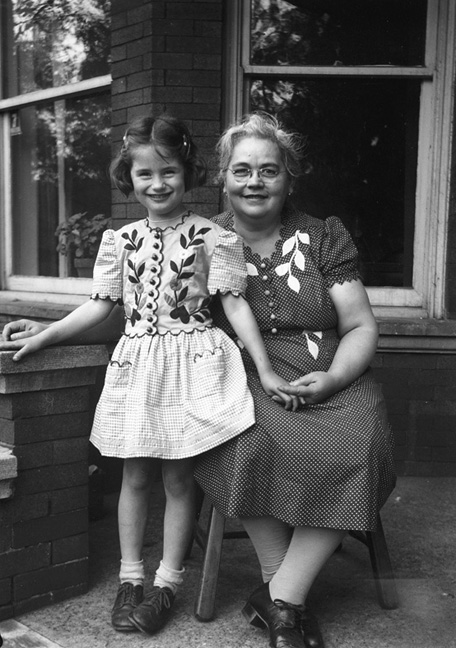
Mary and her granddaughter Susan.

1. Hungarian Girls, 1941, 78 x 94 inches
Owner: Doris Gasperik
Awards: First prize, Illinois State Fair, 1943;
Grand award, Illinois State Fair, 1960;
Displayed in Chicago department stores.
This quilt was one of Mary Gasperik’s favorites. The costumes worn by the peasant girls represent typical native Hungarian dress. The couple in the center was duplicated in a framed wall hanging given to Mary Gasperik’s daughter Elsie (and now owned by her granddaughter Linda). Elmer and Doris Gasperik picked this quilt as their “first choice” when about 20 quilts and tops were divided among family members after Mary’s death. Notice the gracefully bending flowers in pots between the girls, as well as the delicate white embroidery on the sleeves.

2. Hosannah, 74 x 91 inches
Owner: Doris Gasperik
“Hosannah,” a traditional pattern, is also called “The Palm” and is said to originate in pre-revolutionary Maine. Mary used a traditional setting from a traditional pattern, but note the striped inner border and the unusually cut corners. Mary always added something of her own design to enhance every quilt.

3. Indiana Wreath, 1940s, 73 x 99 inches
Owner: Doris Gasperik
One of four surviving “Indiana Wreath” quilts made by Mary about 50 years ago, this lovely quilt is distinct because only pin dots and solid fabrics are used. It also has narrow brown leaves, rather than the green ones used on some of the other quilts and has wheat sheaves under the vase as well as grapes covering it.
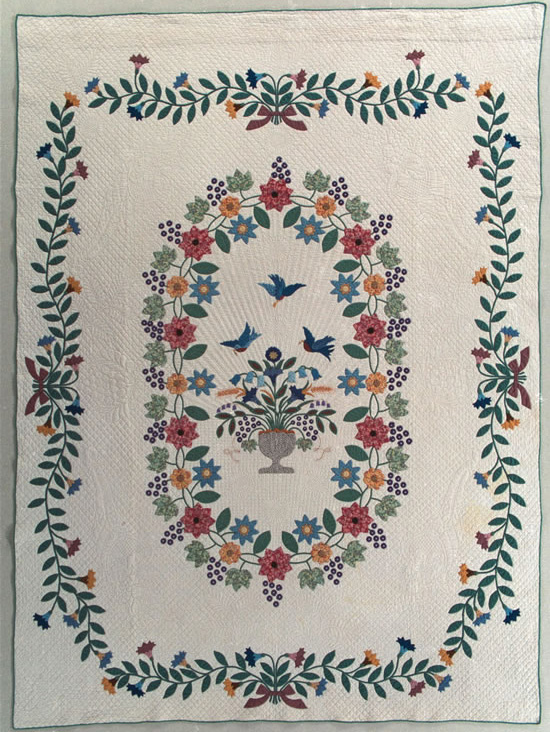
4. Indiana Wreath , 1940s, 73 x99 inches
Owner: Linda Krueger MacLachlan
The applique on this “Indiana Wreath” is virtually identical to Karen’s (Quilt No. 5), but the quilting is very different. The inspiration for the applique design was probably Rose Kretsinger’s 1927 Indiana Wreath, although Mary made the central wreath oval rather than round. Notice the quilting on this version, especially the sunburst of double quilting lines, which extend from the top half of the central bouquet to the surrounding wreath.

5. Indiana Wreath, 1940-1945, 80 x 101 inches
Owner: Karen Krueger Finn
The “Indiana Wreath: quilts won ribbons in several state fairs. Since four were made, it is not known which quilt won which ribbon; however, there are photos of some of them displaying ribbons, indicating that a quilt with wheat descending from the bowl (Susan’s or Doris’) was a winner. This perfect condition quilt is Karen’s favorite.

6. Dutch Girl, 1950, 66 x 82 inches
Owner: Doris Gasperik
Award: Second prize, Illinois State Fair. Using only two fabrics, Mary created a charming, pale blue and white quilt, picturing a little girl in Dutch costume and a windmill surrounded with two rows of tulips. Note the embroidery.
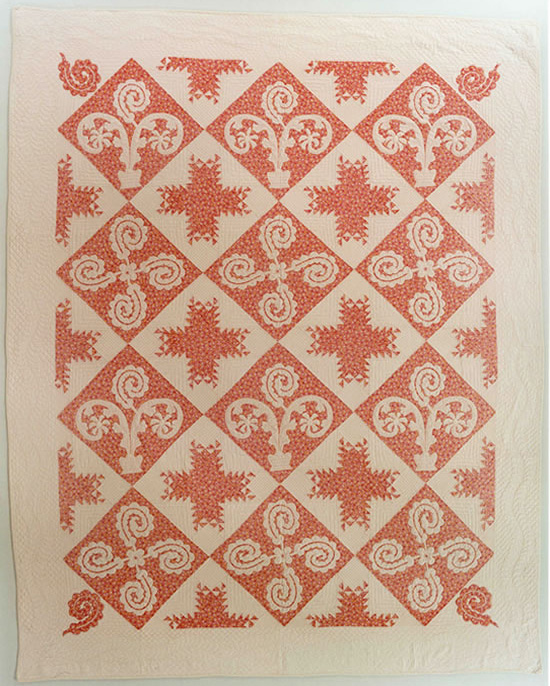
7. Double Feather Star, 1935, 76 x 101 inches
Owner: Susan Krueger Salser
There is a typed “exhibit card” among Mary’s papers reading, “The Double Feather Star. This pattern was originally designed by a Mr. Hamill for his sweetheart, Mary Hayward.” This information was copied from Marie Webster’s book: Quilts, Their Story and How To Make Them. The date and title are embroidered on the back of the quilt. The quilt was well used by Elsie Gasperik Krueger, the owner’s mother, and is faded and worn. The fabrics now are a pale pink solid and a red print; the pink may once have been white.

Photo caption: Mary’s entry in the 1938 Detroit News Quilt Contest hangs against the back wall, left of the gap. It is No. 52 in today’s show. Correction: The photo was NOT taken at the 1938 Detroit News Contest. The photo was taken at a Tuley Park (Chicago) quilt show. The photo is dated October 31, 1936. Enhancement: Four different Gasperik quilts can be seen in this photo: 1-Wedding Bouquet (now at the Los Angeles County Museum of Art, (dated 1933 on the front and embroidered 1936 on the back), bottom row, middle of le
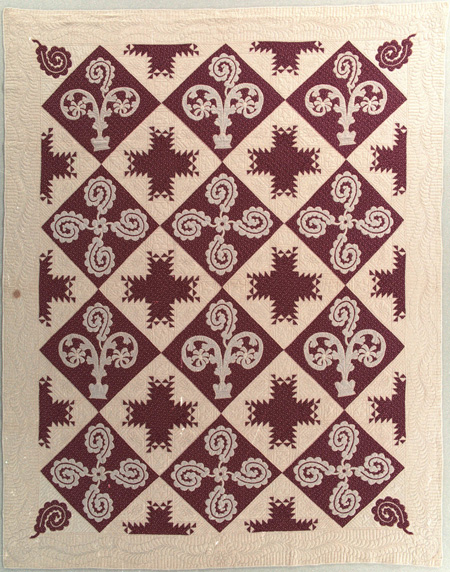
8. Double Feather Star, 1950s, 77 x 100 inches
Owner: Doris Gasperik
This “Double Feather Star” quilt is thought to have been the first prize winner at the 1958 Illinois State Fair. Maroon is a color Mary used very rarely.

9. Indian Feather Star, mid-late 1930s, 77 x 96 inches
Owner: Linda Krueger MacLachlan
In Hall and Kretsinger’s The Romance of the Patchwork Quilt in America, this star pattern is called “California Star.” Mary added six feathers like those in the two previous quilts, plus the flying geese border.
Correction for 9. Indian Feather Star: Mary and her daughter simplified a star block from Marie Webster’s antique “feather star” quilt (figure 35); not from the Hall and Kresinger book.
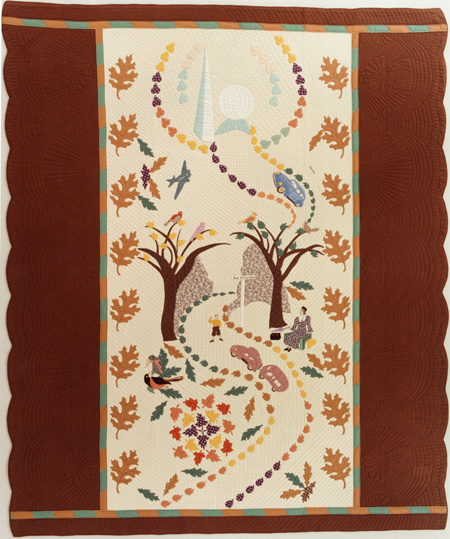
10. Road to Recovery, 1938-1939, 78 x 95 inches
Owner: Karen Krueger Finn
This quilt is very important to Mary. It is her interpretation of the 1930s era, symbolizing the journey from depression to hope and then recovery. The end of the journey is depicted by the Trylon and Perisphere, the symbols of the 1939 New York World’s Fair. The owner says: “While not Grandma Moses, this is definitely Grandma Gasperik.” The following English translation of Mary Gasperik’s Hungarian description of this quilt, “This dear old lady is trying to bear the trials of poverty inflicted upon her by the depression, and in passing along with the years, she must stop and rest to gather fresh courage to reach the World of Tomorrow. Heedless to the traffic, only one thought persists in her mind, to attain her goal. The autumn leaves represent the poverty of the depression as it touched humanity. The birds are singing songs of encouragement. Beyond those mountains lies Recovery, the New York World’s Fair of 1939.”

11. Bridal Bouquet, 1956, 77 x92 inches
Owner: Karen Krueger Finn
Awards: 1957 Illinois State Fair: First Prize for Applique; First Prize for Most Artistic. Mary asked Karen what color she would like her wedding quilt to be. Karen chose pink gingham. Her mother, Elsie, questioned this choice, and now Karen feels her mother may have been right. Mary did as her granddaughter asked, saying that she had never done much work in gingham. Mary used the central lilies design in several of her other quilts. The wonderful quilting in the pink gingham is difficult to see from a distance. At the top of the gingham center are quilted wedding bells. Additional flowers and leaves are quilted throughout, and embroidery adds details to the 16 bouquets encircling the center panel. Karen and her husband have never slept under their wedding quilt, nor has it been washed – hence the original pencil marks remain.

Mary’s 1957 “Bridal Bouquet” entry in the Illinois State Fair, No. 11, took first prize for applique work and for being most artistic.

12. Wedding Quilt, 1944, 72 x 96 inches
Owner: Doris Gasperik
Award: Most artistic, best of show, Illinois State Fair, 1976 This is the first of two wedding quilts made for Mary’s son Elmer and his wife Doris. Mary was a real romantic, and wedding celebrations were especially important to her. In the four hexagons above the white satin wedding bells is the year “1944.” The pink bow and lilies are also made of satin. This quilt was very special to Mary. A somewhat similar wedding quilt was made several years earlier and is owned by the Los Angeles County Museum of Art.

13. Pansies, 1940, 77 x 86 inches
Owner: Linda Krueger MacLachlan
The center of this lovely quilt is a basket of interlaced blue appliqued strips filled with a profusion of purple and yellow pansies. A graceful ribbon of blue surrounds the center medallion. The quilting includes a feathered circle around the basket, and the nine-petaled, fleur de lis toward the corners and center of each side.
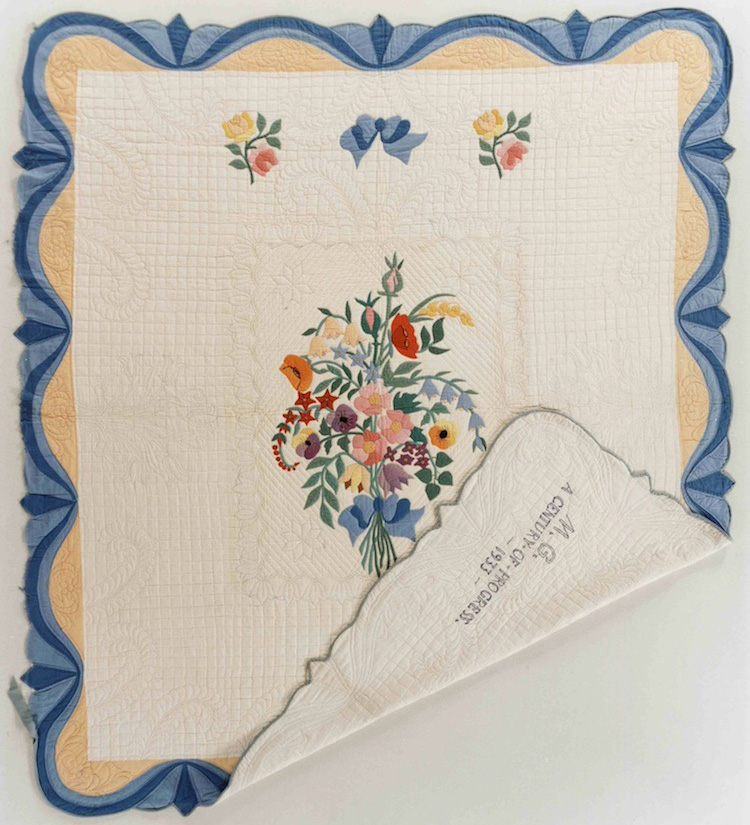
14. Bouquet, 1933, 78 x 88 inches
Owner: Doris Gasperik
“Bouquet” is a magnificent quilt, which was never finished. Only part of one border and its binding is left to do. The family thinks Mary simply ran out of fabric to complete it. It will remain a mystery as to why Mary failed to finish such a small part of this quilt. On the back of the quilt is embroidered: “M.G., ‘A CENTURY OF PROGRESS’, 1933.”

15. Star Arcturus, 1934, 77x 91 inches
Owner: Susan Krueger Salser
The “Star Arcturus” was the motif or logo of the 1933-34 Chicago’s World Fair, whose theme was “Century or Progress International Exposition.” Mary’s quilt notebook contains a similar “Century of Progress” design by Nancy Cabot from a Chicago Tribune column. Mary’s quilt has orange crescent moons with embroidered faces in the four corners, instead of the star “tails” around corners suggest by Mrs. Cabot. Mary also elaborated on the motif, and added small stars in each corner of the “plain” alternating block, as well as a larger star in the center of a quilted wreath. Mary loved this quilt and didn’t understand when it did not receive the same praise from friends and relatives as did her other quilts. She would be very happy to know that this quilt has been selected to be part of a traveling quilt exhibit relating to the 1933-34 Chicago World’s Fair.

16. Colonial Quilting Bee or Betsy Ross, 1930s, 79 x 92 inches
Owner: Linda Krueger MacLachlan
The center of this quilt is comprised of a pieced, miniature example of the Century of Progress “Unknown Star: with appliqued “Lemon” or “LeMoyne” stars in two corners and the “Star Arcturus” in the other two, being quilted by four colonial ladies. Twenty additional ladies “sit” about the rest of the quilt, each with different hair styles, ornaments , appliqued dresses, and each working on a different quilt. Faces, hands, shows, hair, sleeve and petticoat ruffles and chair backs are all appliqued. Centered above the framed quilt, Betsy Ross sits face-on, sewing the original Stars and Stripes. Centered below the framed quilt is a Hungarian girl sewing the Hungarian flag (with the old Austro-Hungarian Imperial coat-of-arms rather than the more recent red star). Her outfit and decorative embroidery are similar to that on the Hungarian Girls Harvest Festival Quilt (No. 1). This quilt, with its clever quilt within a quilt, was Mary’s pride and joy, and one she showed at every opportunity. It depicts what she loved best: quilting, America and Hungary-the land of her birth.

17. Peach Posy, 1940s, 68 x 96 inches
Owner: Doris Gasperik
Mary’s son Elmer and his wife Doris used this quilt and a similar one extensively. The pair were made for their sons Robert and Michael. The two quilts differ slightly in their quilting – one has an unquilted border. This is an unusual setting for the 12 blocks. The blocks are set in two rows surrounded by a very thin bands of brown border fabric and an extensive amount of fancy quilting.

18. Applique’ Children’s Dresses
Owners: Three granddaughters
Several children’s dresses made by Mary for granddaughters Karen, Linda and Susan Krueger.

19. Pink Leaf, 1944, 73 x 88 inches
Owner: Doris Gasperik
Award: First prize, Illinois State Fair, 1944
This pink and green, leaf wedding quilt was given by Mary to her son Elmer and his wife Doris as a first wedding anniversary gift. In the center are quilted a pair of bells and the couple’s wedding year, 1944. The yellow lilies on the top of this quilt were duplicated in an applique wall hanging and later in white on a wedding bouquet quilt for granddaughter Karen.

20. Blue Leaf with Blue Birds, 1944, 84 x 93 inches
Owner: Karen Krueger Finn
Mary made three or four quilts which included four roes of leaves on vines with similar oval wreaths of flowers and leaves. Each had other additional details. This quilt, which she gave to her daughter Elsie, has three appliqued bluebirds, each carrying a pink flower in its beak. At the top of the quilt is a pink bow surrounded by appliqued flowers. In the center of the oval wreath is quilted, in great detail, a basket of flowers. Note the embroidered details and the spectacular quilting, especially of the birds surrounding the top bow.

21. Leaf and Vine, 1954, 84 x 94 inches
Owner: Louise Gasperik
This strikingly dramatic quilt uses much more contrast than most of Mary’s other quilts. The strong burgundy against rose and cream shows her precise applique skill and tiny quilting stitches to good advantage. To this familiar leaf and vine design, she has added a variation on a laurel leaf design in the center top. This quilt was selected by Elsie Gasperik Krueger, on behalf of Mary, to be given to Mary’s granddaughter Louise.

22. Tree of Life, 1938, 68 x 89 inches
Owner: Linda Krueger MacLachlan,
Elsie C. Krueger Mary’s daughter, adapted this design from a Kaumagraph transfer pattern. When Elsie showed her mother the design, Mary demanded that Elsie add more birds. Elsie refused, saying it would make the design too cluttered. Mary quilted in the four additional birds she wanted. The date “1938” is quilted at the center top. Because this is Linda’s birthday year, she was promised this quilt as a child. This quilt has the finest quilting (12 stitches per inch on front and back) of any that Linda owns.

23. Tree of Life, late 1930’s, 66 x 91 inches
Owner: Susan Krueger Salser
This quilt has a name label on the back, indicating it was exhibited. It is not clear, however, which of the five “Tree of Life” quilts won first prize in the 1842 Illinois State Fair for artistic merit and which won second prize in the 1940 Detroit News Contest. Note the wonderful appliqued birds. Compare the quilting patterns, number of trunks, colors and placement of flowers and birds, and finished edge shape with the other two “Trees.” The batting in this quilt is about two inches short on the top and bottom.
Correction for #23 Tree of Life: the label on the back indicates is was exhibited somewhere, but not where or when. 1842 should be 1942 when there was no Illinois State Fair. Gasperik’s “Hungarian Harvest” quilt won 2nd prize in 1940 in Detroit, not one of her “Tree of Life” quilts. However, a “Tree of Life” quilt by Mrs. Charles Voelker did win the grand prize at that show.

24. Tree of Life, 1942, 71 x 90 inches
Owner: Karen Krueger Finn
Karen thinks this was the last “Tree of Life” quilt made, because it is the only one with two trunks. She treasures it because her mother, Elsie, was involved in the design. Besides the two “Tree of Life” quilts her sisters own, two were given as wedding gifts to one of their mother’s friends. Look in the quilting for the date “1942” and three birds, as well as a large squirrel at the bottom, sitting in the grass.

25. Daisies Won’t Tell, 1940’s 76 x 94 inches
Owner: Susan Krueger Salser
Awards: First prize, Illinois State Fair.
An unusual lettering style spells out “Loves Me Loves Me Not” above and “Daisies Won’t Tell” under the heart, formed by a double row of appliqued white daisies on a soft green background. Very fine diamond cross-hatching (1/4 inch), fills the central area of the quilt. Larger (1/2-inch) cross-hatching, interrupted by several quilted leaf patterns, fills the surrounding area to the borders. This is a superb example of Mary’s artistry, and is in perfect condition.
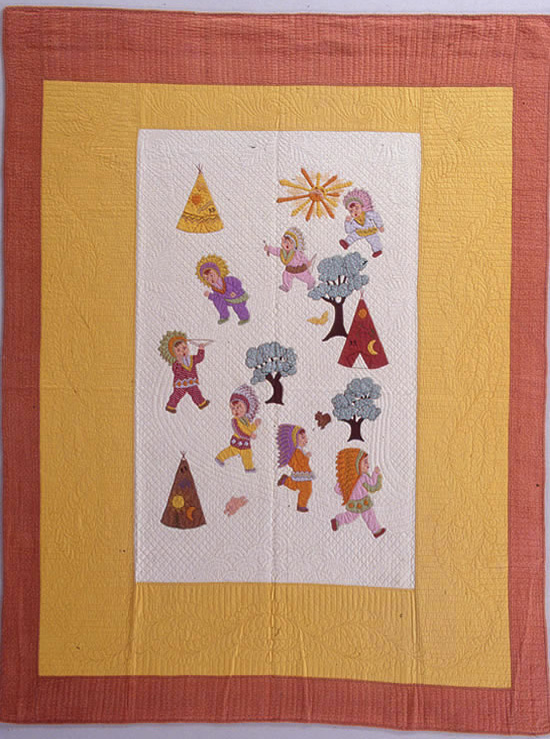
26. Indians, Mid-1950s, 63 x 81 inches
Owner: Robert Gasperik
Mary gave a “Seven Little Indians” quilt to six of her grandchildren. Each of the “Indian” quilts has three appliqued trees, a bird, a rabbit and a squirrel. The suns on the quilts made in the 1950s are appliqued, as well as embroidered. The colors and the quilting patterns were similar, but never identical.

27. Indian Boys, early 1940s, 54 x 68 inches
Owner: Linda Krueger MacLachlan
Each of the “Indians” quilts made for Mary’s grandchildren had the same appliqued components, but different fabrics and different quilted designs. The quilting in this version includes an Indian bust in the lower center, intertwined feathered vines in the yellow border and water lilies in the upper corners.

28. Indians, Mid-1950s, 66 x 79 inches
Owner: Doris Gasperik and son
Award: First prize, best novelty, Illinois State Fair, 1954
This “Indians” quilt was made for Mary’s grandson, Michael. It is similar to the two others made for his brothers. They were made 10 years after those made for her granddaughters. Note that this quilt was expanded to fit a larger bed. The Indian’s hair is embroidered and there is an extra rabbit.

29. Indians, 1943, 52 x 66 inches
Owner: Karen Krueger Finn
Look for the five elephants quilted into this “Indians” quilt, but note the absence of a buffalo or Indian bust. The owner used this favorite quilt to convince her three sons to take a nap when they were three and four years of age.
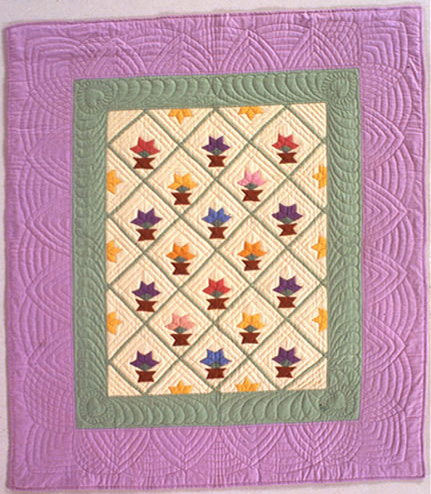
30. Cactus, 1959, 45 x53 inches
Owner: Karen Krueger Finn
Award: Second prize, 1960 Illinois State Fair “Cactus” was made for Karen’s son David when Mary was 72. It has never been sued and is in mint condition. Unlike most of her quilts, it does not have any embroidery or printed fabric in it. The quilt uses a traditional diagonal setting and very narrow strips to separate blocks.

31. Snowflake, prior to 1953, 83 x 96 inches
Owner: Karen Krueger Finn
Elsie Krueger gave her daughter this “Snowflake” quilt in about 1968. Karen admits that it is her least favorite quilt, and she forget about if for about 15 years. It appears to be a kit quilt with the colored stars added. It has no border, which is very unusual for Mary.

32. Calico Rose, 1940’s, 85 x 97 inches
Owner: Susan Krueger Salser
Award: Second prize in Marshall Field Exhibit, 1942 Mary performs her usual magic with fabric and colors in this charming, traditional pattern set in a traditional manner. The quilting, however, is not as close or as inventive as in her other quilts. Notice the lovely swag borders with fleur de lis.

33. Grandmother’s Victory Garden, 1942, 84 x 98 inches
Owner. Charlie Gasperik Shipp
“Grandmother’s Victory Garden” is a wonderful explosion of color in a non-traditional “grandmother’s flower garden” setting. The rather formal “laurel wreath”-like appliques are a strange addition, as are the letter “Vs” in the corners. It is traditionally and simply quilted.

34. Delectable Mountains, 1953, 84 x 100 inches
Owner: David Gasperik
Award: First prize, Illinois State Fair, 1960
This traditional pattern is enhanced by the addition of four graceful birds appliqued near the center and with “Pine Tree” blocks around the edge. There are also quilted birds, feathers, leaves and cross hatching.

35. Farmer in the Dell, 1939-1940, 50 x 68 inches
Owner: Karen Krueger Finn
Mary added real pockets to this quilt because the owner told her pockets should not be fake. Although Mary probably never flew in an airplane, she felt them important enough to include on several quilts and had to be talked out of putting them on others. Notice all of the wonderful embroidered touches which add so much to the quilt.
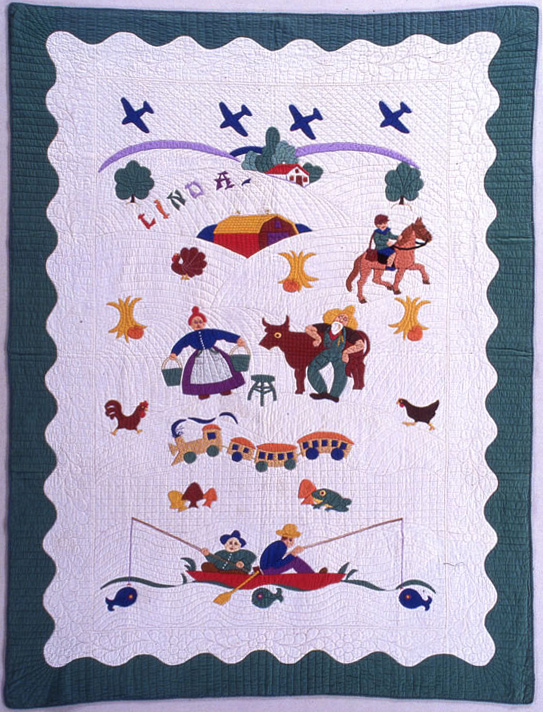
36. Farmer in the Dell, 1939-1940, 50 x 39 inches
Owner: Linda Krueger MacLachlan
Linda adored this quilt as a young child and loved having it on her bed because the farmer’s beard is fuzzy, and he and the milkmaid have real pockets. Her mother told her that the little boy riding to school was intended to represent Linda’s father, who did ride to school on horseback when he was 11-14 years old.

Linda, left, and Karen slept with tow of the “Farmer in the Dell,” No. 35-36, quilts in the mid-1950’s.

37. Morning Glory, 1960, 68 x 102 inches
Owner: Karen Krueger Finn
Award: Illinois State Fair, early 1960s
Marie Webster’s book (referred to in the book Quilts, Their Story and How to Make Them, No. 7) shows a similar quilt with the flowers and leaves, made them plumper and fuller, and arranged them in a rectangular wreath. Notice the central, quilted oval feathered medallion with a double row of quilting radiating out to the applique. The three shades of apricot scallops in the border are typical of Mary’s quilts. This may have been the last quilt that Mary completed.
Correction for 37. Morning Glory: There is no evidence the quilt was made in the early 1960s or that it might have been the last quilt Mary Gasperik made. The similar Marie Webster quilt is found in the Ladies Home Journal in 1912, not in her book, Quilts, Their Story and How to Make Them. Mary completed two apricot morning glory quilts, though they are not a pair (the quilting on each is quite different). One of them was described by Mary as “one of her first prize winning quilts” in an album sent to Germany in 1945.

38. Morning Glory, 65 x 97 inches
Owner: Doris Gasperik
This is one of a pair of quilts done in three shades of blue, both exactly alike. These quilts have been much-loved and frequently used.

39. Double Trellis, 1933, 72 x 91 inches
Owner: Susan Krueger Salser
Susan thinks this is Mary’s first completed cotton applique quilt. On the back is embroidered “M.G. Century of Progress 1933.” Notice the triangles are appliqued and not pieced. The presence of knots on the outside indicates she was still learning the basics of quilt making. Simple, large, appliqued red posies climb the two trellises and frame the embroidered “M.G.” on the front. Susan especially likes the color choice – Hungary’s national colors. Mary came to regard this quilt as “primitive” and “unaccomplished” and thus, never displayed it. Her later quilts used less coarse cotton and thinner batting. This quilting is simple and widely spaced.

40. Blue Pinwheel, mid-late 1930s, 61 x 98 inches
Owner: Karen Krueger Finn
This is one of a pair of quilts, made from rough “homespun” cotton and an indigo blue calico print, that often topped one of the stacks of quilts Mary stored on two beds. Although Karen always saw muslin fabric covering the stack, this quilt has been noticeably used and is slightly faded.

41. Baby Blocks, 1958-1959, 46 x 65 inches
Owner: Linda Krueger MacLachlan
Award: Blue ribbon at Illinois State Fair
This was a birth gift for Mary’s great-grandson born in February 1959. Notice the touches of embroidery on the appliques and the interior scallops in the pink, inner border and the quilted baby blocks.

42. Smiling Doll, 1945, 48 x 63 inches
Owner: Susan Krueger Salser
The doll on this quilt originally had a pout on her lips, but Susan replaced it with a more pleasing smile in 1968. Susan never resembled the chubby, curly-haired, blue-eyed blonde doll and grew up feeling that her grandmother wished that she had. Notice the elaborately patterned quilting radiating from the central area.

43. Four Pigs, 1937, 38 x 42 inches
Owner: Karen Krueger Finn
This was designed by Elsie Garperik Krueger and made by Mary for Karen, her granddaughter. “The Four Pigs” was used by three granddaughters and three great-grandsons and was much used and enjoyed by all. “My grandmother did a great pig face, unlike the girl doll faces,” says Karen.

44. What are Little Boys Made Of?, 1957, 48 x 72 inches
Owner: Karen Krueger Finn
Award: First prize, best novelty quilt, Illinois State Fair, 1957 Made for Mary’s first great-grandchild, Andrew Finn, born June 1957, this quilt has never been used. Quilted designs include sailboats, fish, cornucopias and flowers. The boys’ garments include “real” pockets and buttons. Several fabrics in this quilt were used to make appliqued dresses for her granddaughters 20 years earlier. Embroidered details are in the boys and animals, but not on the flowers.

45. What are Little Girls Made Of? 1939-1940, 22 x 23 inches
Owner: Karen Krueger Finn
Award: Prize in Detroit News Contest, 1940
This quilt was made for Karen when she was in pre-school. Mary liked to applique chubby blond girls. Although Karen was never blond, she admits to being chubby. She used this in her doll buggy to cover her Shirley Temple doll.

Mary and husband Stephen, with the quilt “What are Little Girls Made Of?,” No. 45.

46. Salmon Whole Cloth, 37 x 44 inches
Owner: Doris Gasperik
Mary made many similar quilts for her grandchildren, several of which have been worn out. This one received care. The quilting designs are farther apart on this quilt, which could indicate that it was made early in Mary’s quilting career.

47. Satin Whole Cloth, 1937-1938, 34 x 51 inches
Owner: Linda Krueger MacLachlan
The quilting on this satin piece includes a central tear-drop shaped medallion outlined with feathering and a feathered wreath in each corner. Made for Linda’s birth in January 1938, this quilt remains in excellent condition because it can be encased in its own white percale cover with eyelet-trimmed, central cut-out in the shape of the middle medallion.

48. Trip Around the World, 31 x 36 inches
Owner: Linda Krueger MacLachlan
Linda attached a backing to this quilt fragment in February 1992 so that it could be included in this display. Linda thinks the quilt’s small, one-inch squares of many colors are in keeping with one of Mary’s quilting phases. It is unknown how Mary planned to use this piece.

49. Nursery Rhyme, 74 x 91 inches
Owner: Doris Gasperik
Award: Illinois State Fair, 1950s
Made for one of Mary’s grandchildren, this delicate quilt has the scallops she loved on both sides of the yellow border. Notice the wonderful embroidered touches on the children. This design probably was not original, but came from a commercial source. Note the faintly visible, stenciled numbers and letters in the lower left edge of the center panel.

50. Red Tulips, 1933, 61 x 95 inches
Owner: Karen Krueger Finn
“Red Tulips” was one of Mary’s first quilts. As a self-taught quilter, she did not know that she should not quilt straight through the applique. When Karen was about 12 years of age and participating in one of the occasional family quilt viewings (Mary would “unpeel” a bed as they all stood around commenting), she said, “Grandma, this is the best of all!,” referring to the “Red Tulip” quilt. Mary immediately gave it to her. The back of this quilt is embroidered “M.G. A CENTURY OF PROGRESS, 1893-1933”. Her English was also self-taught.

51. Pink Rose Wreath, 1938, 74 x 95 inches
Owner: Kathy Gasperik Wessing
Awards: First prize, Michigan State Fair; Second prize, Indiana State Fair, Fourth prize, Detroit News Contest
Quilted into the top and bottom of the front of this quilt is the year “1938,” while a lovely pink, scalloped border frames delicate rose wreaths. Mary gave this quilt to her youngest granddaughter, Kathy, instead of an Indian Quilt.
Update for 51. Pink Rose Wreath: “Owner: Kathy Gasperik Wessing” should be “Owner: Kathy Gasperik Jacob”. Correction for 51. Pink Rose Wreath: “Fourth prize, Detroit News Contest” should be “First Prize (Finished Appliquéd Quilts, News Pattern), Detroit News Contest 1938." The family calls this quilt “Rose Wreaths” and the Detroit News pattern name was called “Roses and Forget-Me-Nots.”

52. Laurel Wreath, 1935, 86 x 94 inches
Owner: Karen Krueger Finn
Award: First prize in Detroit News patterns, Second highest overall (grand prize), Detroit News Contest, 1938
This “Laurel Wreath” was considered a “big prize winner” because it traveled to several contests. Mary entered the Detroit News’ annual contests at least four times and won at least three times, according to newspaper articles. This colorful quilt has 30 large blocks: 15 individual flowers, 10 flowers set into laurel wreaths and five birds set into laurel wreaths. The finely scalloped border is both quilted and appliqued with laurel wreaths. Embroidery is everywhere – on birds, flowers and leaves.

Mary, left, standing, with her quilt “Laurel Wreath,” No. 52, with Tuley Park Quilt Club members, Tuley Park, Chicago, October 30, 1936.
Correction for 52. Laurel Wreath: Mary Gasperik won many prizes and honorable mention ribbons at the 1935, 1937, 1938, and 1940, Detroit News Quilt Shows. The News published prize lists, but they did not list the names of the quilts. There is no complete inventory of which quilts were displayed and which ribbons each quilt won. In 1937 we know she submitted four quilts and won four honorable mention ribbons. Her highest prize, a first in finished applique, was at the 1938 show. She won a second prize in the applique quilts category at the 1940 show. Mary Gasperik was an eager competitor who encouraged fellow south side Chicago quilters to travel by bus with her to the Detroit News shows.

53. Field of Flowers, 77 x 88 inches
Owner: Susan Krueger Salser
Each of the charming wreaths in this quilt is the same, but oriented differently. The fabric choices for the birds are wonderful, and Susan remembers her mother having a blouse from one of the bird fabrics. Notice the wheat sprigs and all the lovely embroidery on the flowers. Susan thinks this quilt was made after Mary’s husband Stephen, retired and they bought a house in East Hazelcrest, Ill. Mary loved growing fruits, vegetables and flowers, and Susan sees this quilt as the one that reflects that side of Mary: the happy, outdoor gardener.
-
Legacy
Gasperik Legacy Project, Mary -
Quiltmaker
Gasperik, Mary Mary Gasperik Legacy Project
-
Ephemera
One-woman quilt exhibition
Valley Times
-
Ephemera
The Quilts of Mary Gasperik
Salser, Susan
-
Ephemera
Womenfolk 08. Depression Era Quilts: C...
Breneman, Judy Anne
-
1938-1940
Hungarian Harvest... Gasperik, Mary
-
1941
Hosannah Gasperik, Mary
-
1938-1945
Indiana Wreath Gasperik, Mary
-
1938-1945
Indiana Wreath Gasperik, Mary
-
1940s
Indiana Wreath Gasperik, Mary
-
1950
Dutch Girl Gasperik, Mary
-
1935
Double Feather St... Gasperik, Mary
-
1937 circa
Double Feather St... Gasperik, Mary
-
1935-1950
Indian Feather St... Gasperik, Mary
-
1939
Road to Recovery Gasperik, Mary
-
1956
Bridal Bouquet Gasperik, Mary
-
1944
Bridal Bouquet Gasperik, Mary
-
1935-1945
Pansies Gasperik, Mary
-
1934
Star Arcturus-Cen... Gasperik, Mary
-
1935-1940
Colonial Quilting... Gasperik, Mary
-
1934
Peach Posy Gasperik, Mary
-
1939-1943
Dress - Dutch Boy... Gasperik, Mary
-
1944
Leaf and Vine Gasperik, Mary
-
1944
Leaf and Vine Gasperik, Mary
-
1940s
Leaf and Vine Gasperik, Mary
-
1938
Tree of Life Gasperik, Mary
-
1935-1945
Tree of Life Gasperik, Mary
-
1942
Tree of Life Gasperik, Mary
-
1940-1946
Daisies Won't Tel... Gasperik, Mary
-
1954
Indians #5 Gasperik, Mary
-
1943-1944
Indians #2 Gasperik, Mary
-
1954
Indians #4 Gasperik, Mary
-
1943-1944
Indians #1 Gasperik, Mary
-
1959
Cactus Basket Gasperik, Mary
-
1930s
Snowflakes Gasperik, Mary
Load More